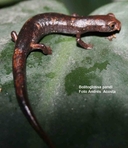|
Bolitoglossa pandi Brame & Wake, 1963
Pandi Mushroomtongue Salamander Subgenus: Eladinea | family: Plethodontidae subfamily: Hemidactyliinae genus: Bolitoglossa |
 © 2008 Andrés Acosta (1 of 12) |
|
|
Author: Jean Raffaëlli Bolitoglossa (Eladinea) pandi Brame & Wake, 1963 5 cm SVL (F). Nombre de dents maxillaires modéré (39). Doigts et orteils presque intégralement palmés. Museau parfois tronqué. Queue courte. Membres modérés. Parties supérieures gris rougeâtre teinté de bleu. Grandes taches crème sur les parties ventrales, ventrolatérales et sous la queue. * Environs de la localité-type, municipalité de Pandi, département de Cundinamarca, Colombie centrale, à 1 300 m, dans une région assez sèche. Distribution peut-être plus large. Dans la végétation basse en bordure de forêt. Habitat fragmenté par l’agriculture. 29 km2. Au bord de l'extinction. EN. From Les Urodèles du Monde, 1e edition, 2007: Bolitoglossa (Eladinea) pandi Brame et Wake, 1963 Ancien groupe adspersa. 5 cm SVL. Nombre de dents maxillaires modéré (39). Doigts et orteils presque intégralement palmés. Museau parfois tronqué. Queue courte. Membres modérés. Parties supérieures gris rougeâtre teinté de bleu. Grandes taches crème sur les parties ventrales, ventro-latérales et sous la queue. Environs de la localité-type, municipalité de Pandi, département de Cundinamarca, Colom bie centrale, à 1300m, dans une région assez sèche. Distribution peut-être plus large. Dans la végétation basse en bordure de forêt. 29 km2. EN. Habitat fragmenté par l’agriculture. Peut-être éteinte.  ENGLISH TRANSLATION - Julian Wittische, December 2011 ENGLISH TRANSLATION - Julian Wittische, December 2011 Bolitoglossa pandi was formerly part of the adspersa group. It has a SVL of 5 cm. It has 39 maxillary teeth (a moderate number compared with other species of its group). The fingers and toes are almost entirely webbed. The snout is sometimes truncated. It has a short tail. The limbs are medium- sized; Dorsal sides are reddish grey with some blue. There are big cream-colored spots on the ventral sides, on the ventral side of the flanks and on the ventral side of the tail. Habitat & Range: Surroundings are of the type-locality, Pandi (municipality), Cundinamarca Department, central Colombia, at an altitude of 1300 m, in a rather dry area. The range may be bigger. It is found in the low vegetation at forest edges, 29 km2. Conservation: Its status is considered Endangered (critically?). The habitat is fragmented by agriculture. It may be extinct. Feedback or comments about this page.
Citation: AmphibiaWeb. 2024. <https://amphibiaweb.org> University of California, Berkeley, CA, USA. Accessed 25 Apr 2024. AmphibiaWeb's policy on data use. |


 Raffaëlli Account
Raffaëlli Account Map of Life
Map of Life